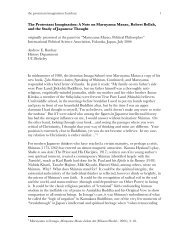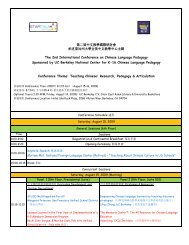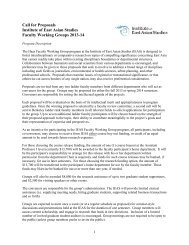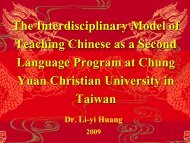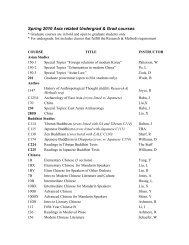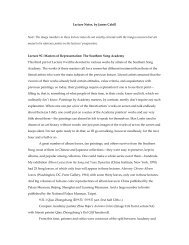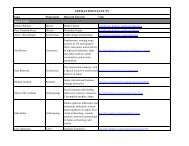Third Edition Spring 2013 - Institute of East Asian Studies, UC ...
Third Edition Spring 2013 - Institute of East Asian Studies, UC ...
Third Edition Spring 2013 - Institute of East Asian Studies, UC ...
Create successful ePaper yourself
Turn your PDF publications into a flip-book with our unique Google optimized e-Paper software.
Thus, the Arthashastra remains as relevant today as duringthe era <strong>of</strong> feudal states because “There is probably no place or system<strong>of</strong> controlling the world today that more closely resembles thehighly competitive, dangerous, and fast moving world <strong>of</strong> the feudalstate, with the accompanying great rewards for success, andgreat punishment for failure than the modern business or corporation.”15 Kautilya’s treatise is focused primarily on forming andthen controlling <strong>of</strong> a very particular type <strong>of</strong> organizational structure.He provides a practical way for managing these specific structures.Due to the inherent similarities between the structures <strong>of</strong>the political states described by Kautilya and the modern corporation,Starzl and Dhir claim that “the mapping <strong>of</strong> the structure <strong>of</strong>a corporation onto the structure <strong>of</strong> feudal states is not too difficultto do, and thus the application <strong>of</strong> the Arthashastra to the moderncorporate world should be no more difficult to accomplish.” 16 AsStarzl and Dhir have shown, the Arthashastra is relevant to the corporateworld and its strategies can be applied to the management<strong>of</strong> corporate structures. There is certainly potential for Kautilya’sstrategies to have a significant impact on the formation and maintenance<strong>of</strong> corporations, which are—from a purely organizationaland structural standpoint—the modern day equivalent <strong>of</strong> feudalstates.Following Starzl and Dhir demonstrating that the strategies<strong>of</strong> the Arthashastra are applicable to the corporate world due tothe similarities in structural organization between the ideal Kautilyanfeudal state and the modern corporation, scholars beganto apply Kautilyan strategies to business. One such example is N.Siva Kumar and U.S. Rao’s derivation <strong>of</strong> value-based managementguidelines from the Arthashastra. Value-based management refersto the management approach that ensures corporations are managedconsistently on value, usually with the focus <strong>of</strong> maximizingshareholder value. Kumar and Rao’s approach for developing a“value based management framework” focused on five key components:“organizational philosophy, valued based leadership, inter-15 Timothy Starzl, and Krishna Dhir, “Strategic Planning 2300 Years Ago: TheStrategy <strong>of</strong> Kautilya,” Management International Review, 26, no. 4 (1986): 76.16 Ibid.nal corporate culture, accomplishment <strong>of</strong> corporate purpose andfeedback from stakeholders.” 17 Kumar and Rao show that Kautilya’sArthashastra provides guidelines for each component <strong>of</strong> themanagement framework, thus displaying the relevance <strong>of</strong> the Arthashastrato the world <strong>of</strong> modern corporations.I will now examine these five components, in both the strictKautilyan sense and the application <strong>of</strong> Kautilyan strategies to value-basedmanagement, in order to demonstrate specific applications<strong>of</strong> the Arthashastra to modern business and economics. Indiscussing the organizational philosophy—or purpose <strong>of</strong> existence—<strong>of</strong>the state, Kautilya believed that a welfare state exists forthe benefit <strong>of</strong> its people, as shown in Book I <strong>of</strong> the Arthashastrawhere Kautilya writes that the king’s welfare lies in the welfare <strong>of</strong>his people. When applying these guidelines to value-based management,it translates into corporations or businesses existing forthe benefit <strong>of</strong> its stakeholders and society. 18 Kumar and Rao thengo on to discuss Kautilya’s guidelines for value-based leadership,the second component <strong>of</strong> their framework. “The leader’s primarygoal according to the Arthashastra is to fulfill the philosophy <strong>of</strong>the organization.” 19 Thus, a good leader exists solely for the benefit<strong>of</strong> those he leads. In order to realize the goals <strong>of</strong> an organization,the Kautilyan leader must be virtuous and selfless, and hemust lead by example. 20 The next component <strong>of</strong> Kumar and Rao’sKautilyan model <strong>of</strong> value-based management is an organizationalculture that promotes value-based management. The two scholarsmention that a major problem in modern corporations is thelack <strong>of</strong> a moral corporate culture that promotes ethical behavioramong its employees. 21 Unlike many modern corporations, Kautilya’sArthashastra does promote a moral culture by requiringcertain values from the organization’s members, only appointing<strong>of</strong>ficials based on character and conduct, rewarding righteousbehavior, and punishing unethical behavior. 22 The application <strong>of</strong>17 N. Siva Kumar, and U.S. Rao, “Guidelines for Value Based Management in Kautilya’sArthashastra,” Journal <strong>of</strong> Business Ethics, 15, no. 4 (1996), 41518 Ibid., 41619 Ibid.20 Ibid., 416-41721 Ibid., 41922 Ibid., 419-42061 Ramanathan Veerappan Kautilya’s Arthashastra 62




